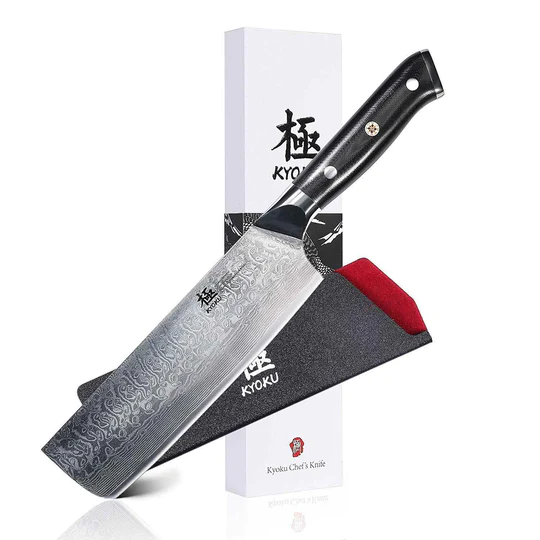


Ever wondered if your knife sharpener is a forever tool or if, eventually, it just gives up? Knife sharpeners do go bad over time, especially with regular use and not-so-great maintenance. Figuring out when your sharpener’s past its prime can help keep your kitchen knives actually sharp, not just “good enough.”
It’s easy to miss the slow fade, but as the grit or abrasive surface gets smoother, you’ll notice it takes way more effort to get a sharp edge. Sharpening gets harder and less rewarding.
Pull-through sharpeners and sharpening rods don’t all last the same amount of time, either. It depends on how you use them and what knives you’re working on. There’s even debate about how some pull-through sharpeners can wear out your knives and when you should just get a new sharpener.
Knife sharpeners definitely wear down with regular use. How long they last and how sharp they keep your knives depends on the material, the style of sharpener, and how often you’re using it.
If your knives just aren’t getting sharp anymore, even after a sharpening session, it’s a big red flag. When sharpening takes longer and the results are “meh,” your sharpener’s probably worn.
A sharpener that scratches or damages your knife edge has probably lost its grit or surface texture. Buildup of metal filings or deep grooves on the sharpener’s surface are also signs of heavy wear.
Common issues that mean your sharpener’s on its way out:
If you clean your sharpener regularly, you’ll spot these things early. When these problems keep showing up, it’s probably time to replace your sharpening tool.
Not all sharpeners are created equal. Ceramic rods, diamond plates, and whetstones all have different lifespans, mostly depending on their grit and quality. Cheaper sharpeners lose their bite faster. If you only sharpen your knives when they actually need it, your tool will stick around longer.
Harder kitchen knives put more stress on your sharpener’s surface. How you care for your sharpener matters too—clean off metal dust and store it somewhere dry to avoid rust and other damage.
How often you sharpen is a big deal. If you only touch up your knives a few times a month, a good sharpener can last for years. But daily or heavy commercial use will wear it out way faster.
Knife sharpeners come in all shapes and sizes. Each kind has its own quirks, maintenance needs, and lifespan. What they’re made from, and how often you use them, really does affect how long they’ll stick around.

Electric knife sharpeners (think Chef’s Choice and similar brands) are fast and easy, but their abrasive wheels do wear down after a while. If you use yours a lot, those grinding surfaces might lose their edge in just a couple of years.
One downside: electric sharpeners usually take off more metal than manual tools. That’s tough on both your knives and the sharpener itself. Motors can burn out too, especially if you forget to clean out dust or run the machine for long stretches without a break.
You can help your electric sharpener last by cleaning out metal shavings after each use and not forcing thick or damaged knives through it. Honestly, electric sharpeners are best for routine touch-ups, not for fixing big chips or totally reshaping blades.
Sharpening stones and whetstones are pretty simple and can stick around for years, sometimes decades, if you take care of them. The main thing to watch for is uneven wear, like grooves or dips forming after lots of use. When that happens, your stone won’t sharpen evenly. You can flatten it out with a leveling tool or a coarse diamond plate.
Keep your whetstone clean and let it dry completely before storing it. Some stones get soft or even crack if you leave them soaking or put them away while damp. Always check the care instructions for your specific stone. Diamond sharpening stones usually last longer than softer water stones, but if you go at them aggressively, they’ll lose grit too.
Using a whetstone or sharpening stone gives you more control over the sharpening process than electric sharpeners. It takes patience and a bit of practice, but you’ll help your knives and your stone last longer if you do it right.
Sharpening steels (honing rods) aren’t true sharpeners. They don’t really remove metal. They just realign the knife’s edge. Over time, though, the surface of a steel rod gets too smooth and stops doing its job. Harder knives and frequent use speed this up.
A chrome-plated steel rod might last for years in a home kitchen, but in a busy professional setting, it’ll wear out a lot faster. Ceramic and diamond-coated rods hang in there longer but still need replacing once they’re smooth or chipped.
Wipe your sharpening steel after each use and keep an eye out for nicks or deep scratches. Store it somewhere dry so it doesn’t rust. Good habits can help a sharpening steel last, but eventually, they all need to be swapped out.
Not every knife is the same, and honestly, the kind of knife you have makes a big difference in how well a sharpener works—and how long your blade stays sharp.

Japanese knives are usually made from harder steel than Western knives. They’re thinner, with a steeper sharpening angle (think 10°–15°). Western knives are thicker, with a wider angle (closer to 20°).
Because of all this, pull-through sharpeners made for Western knives don’t really work for traditional Japanese knives. You can damage a fine Japanese edge or just grind away too much steel if you use the wrong tool. Whetstones or sharpeners labeled for Japanese knives are much safer. For home cooks, knowing your knife type helps you pick the right sharpener and avoid mistakes that’ll cost you in the long run.
| Type | Compatible Sharpeners | Special Considerations |
|---|---|---|
| Stainless Steel | Most kitchen sharpeners | Sharpen regularly |
| Ceramic | Diamond sharpeners only | Avoid dropping or chipping |
Stainless steel knives are everywhere and can handle most sharpeners, pull-through, whetstones, you name it. They’re tough and a bit forgiving if your sharpening technique isn’t perfect.
Ceramic knives are a whole other story. They’re harder but also more brittle, so you’ll need a special diamond-dust sharpener. Regular sharpeners or stones won’t work, and trying them can chip or crack the blade. Plus, ceramic knives keep their edge longer, but if they chip, you’re probably out of luck.

Serrated blades, like bread knives, are tricky. Their jagged teeth make them tough to sharpen with most handheld sharpeners, so they often just get dull without anyone noticing.
To sharpen a serrated knife, you’ll need a tool made for serrations or a tapered sharpening rod. Pull-through sharpeners can wreck the teeth and mess up the blade’s cutting ability.
Serrated knives don’t need sharpening as often, but when they do, use gentle strokes that follow the shape of each tooth.
Tips:

Taking care of your knife sharpener means it will last longer, and your knives will stay sharper and safer. Use the right techniques, know when to ask for help, and don’t get too aggressive with your sharpening. It’ll save you time, frustration, and probably a bit of cash too.
Regular honing really keeps your knives sharp, and it’s easier on your sharpener, too. Go with light, steady strokes—don’t press down hard. That just wears out your blades and the sharpener faster.
After each use, clean your sharpening tools. Just wipe away any metal dust or debris so it doesn’t pile up and cause problems later. Stash your sharpener somewhere dry to keep rust and other issues at bay.
Only sharpen diamond, ceramic, and steel rods when they actually need it. If your sharpener isn’t working well even after a good cleaning, it might be wearing out. While a decent rod or whetstone can last for years, sometimes you’ll need a new one when it starts to under perform.
If your knives still feel dull after sharpening or have deep nicks, it might be time for a professional. These folks can fix blade problems and get your knives back to a near-new edge.
Some sharpeners, especially the cheap pull-through ones, can wear out fast or even mess up knives. When your sharpener just isn’t cutting it anymore, or your blade feels dull and uneven, maybe try a sharpening service.
Professional sharpening comes in handy if you damage a blade while chopping or want to restore your pricier knives. It’s not something you need all the time, but it can really stretch the life of your tools.
Don’t rush sharpening. Take it slow to keep control and avoid accidents. Hold the knife at the right angle, and use smooth motions so you don’t end up with a weird, uneven edge.
Give your sharpener a quick once-over before each use. Look for chips, cracks, or heavy wear. If it still doesn’t work after a proper cleaning, it’s probably time for a replacement.
Honestly, a whetstone or rod is usually a better bet than most pull-through models. They tend to last longer and are gentler on your knives. The right tools and a bit of care make sharpening easier and keep your kitchen blades ready for anything.
Knife sharpeners do wear out and eventually need replacing, though it depends on the type and how much you use them. Some show obvious wear, while others just need basic care to last longer.
Most knife sharpeners hold up for several years with regular use. If you use a pull-through sharpener a few times a month, you’ll probably get three to five years out of it. Diamond-coated ones might wear out quicker than ceramic or steel versions, though.
Yep, ceramic pull-through sharpeners do wear out. Over years of use, the rods get smooth and don’t sharpen as well. They can even chip or crack if you drop them—so watch out for that.
If you’re needing more strokes to get a decent edge, or your knives still feel dull after sharpening, that’s a red flag. Grooves, uneven surfaces, or peeling abrasive layers all mean it’s time to swap out your sharpener. At that point, it just can’t do the job anymore.

Diamond-coated sharpeners usually don’t last as long—the diamond layer can flake off with lots of use. Ceramic and steel pull-through sharpeners generally stick around longer, but they’ll wear down eventually too.
Yeah, using a pull-through sharpener too much can slowly shave away too much metal, which shortens your blade’s life. Over-sharpening or using a dull sharpener can also mess up the edge and actually make your knives duller.
After each use, just give your sharpener a quick wipe to clear away any metal shavings. Keep it somewhere dry otherwise rust will creep in. If it comes apart, take a glance for broken or worn-out bits and swap them out if you need to. Honestly, regular cleaning goes a long way to keep those abrasive surfaces doing their job.

Knife Buzz offers independent product reviews on a wide range of knives used in the kitchen, home, and outdoors. We make it easy for you to find the right knife at the best price.